Amazon and Shopify are two of the most popular platforms in ecommerce, but they work in fundamentally different ways.
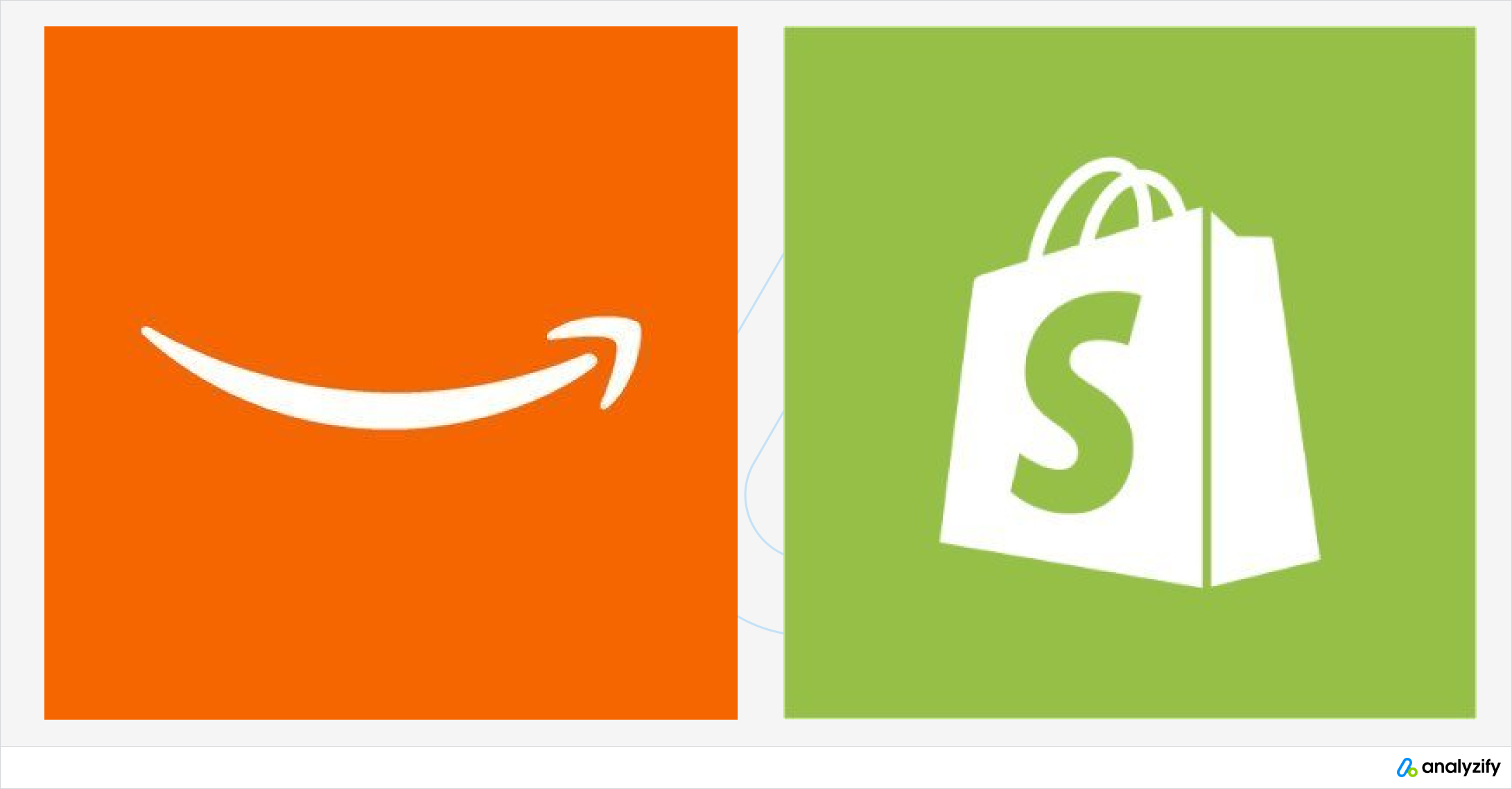
Amazon is a centralized marketplace. You list your products inside Amazon’s ecosystem and get instant access to millions of shoppers.
Shopify, on the other hand, is a decentralized platform. You build your own online store, customize everything, and own the full customer experience.
This Amazon vs. Shopify comparison covers the differences that impact sellers, from pricing and fulfillment to scalability and long-term growth, so you can choose the right fit for your business.
🎯Bonus Content: Shopify Analytics vs Google Analytics – Which One Should You Trust?
Comparing Amazon vs. Shopify in 2025
Before exploring the differences of Amazon vs. Shopify in detail, here’s a side-by-side comparison to highlight key structural differences:
| Category | Amazon | Shopify |
|---|---|---|
| Platform Type | Online marketplace – sell on Amazon alongside others; no control over storefront design | Ecommerce platform – build and fully customize your own branded online store |
| Pricing Plans | Individual: $0/month + $0.99/itemProfessional: $39.99/month | Basic: ~$29/monthShopify: ~$79/monthAdvanced: ~$299/monthPlus: $2,000+/month |
| Sales Fees | 8%–15% referral fee per sale (category-based)+ Fulfillment by Amazon (FBA) fees | 0% transaction fee with Shopify Payments0.5%–2% fee if using external gateways |
| Fulfillment | Fulfillment by Amazon (FBA) or Fulfilled by Merchant (FBM)FBA includes Prime shipping | Self-fulfillment or third-party logisticsShopify Fulfillment Network (limited regions) |
| Scalability | Operational scale is strong (via FBA and built-in traffic)Brand scale is limited | Full control over brand growth, marketing, and dataTechnical and sales scale supported |
| Support | Ticket-based seller supportMixed reviews; strict policy enforcement | 24/7 live chat, email, and phone supportGenerally fast and merchant-oriented |
| Global Reach | Amazon Global Selling + local marketplaces (US, EU, JP, etc.)Cross-border logistics via FBA | Multi-language and multi-currency supportInternational reach depends on seller setup |
Key Capabilities and Customization Comparison
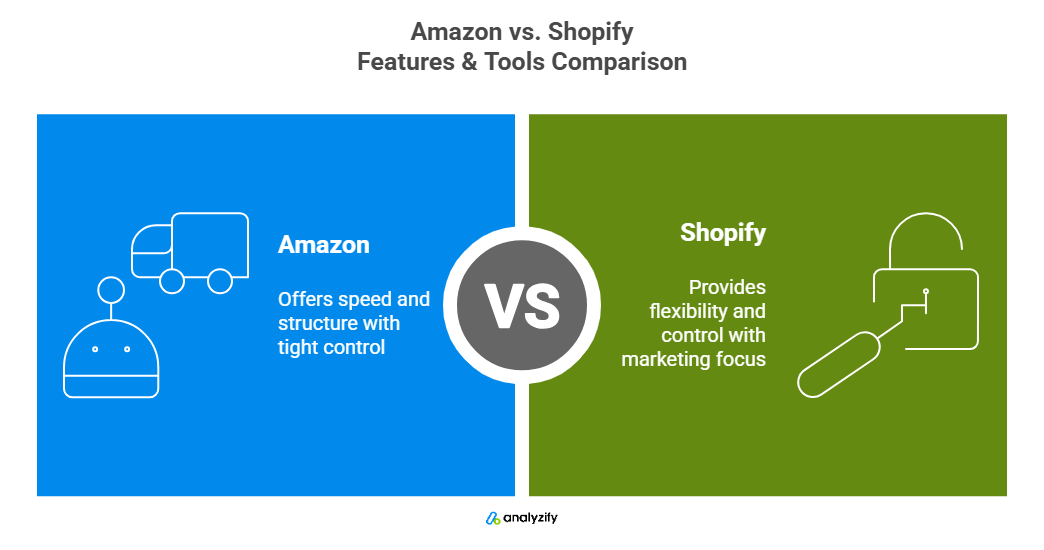
Amazon is built for fast listing and order fulfillment.
Shopify is built for long-term brand ownership and flexibility. Here’s how they differ where it matters:
When it comes to listing and store design:
- Amazon: You don’t get a storefront. All product listings follow a fixed structure, title, images, bullet points, price. There’s no room for design or branding.
- Shopify: You build your own store from the ground up. Themes, layout, colors, product arrangement, everything is in your control.
For sellers thinking about SEO and content marketing:
- Amazon: Your visibility depends on how well you rank in Amazon’s internal search. There’s no blog, no custom URLs, and no opportunity for content-led growth.
- Shopify: SEO is baked in. You can edit URLs, write meta descriptions, publish blog posts, and build authority over time through organic traffic.
In terms of built-in tools that help run the business:
- Amazon: You get the basics, order management, inventory tracking, customer messaging, and paid ads. That’s about it.
- Shopify: More complete out of the box. Product and customer management, discount codes, shipping labels, analytics, and abandoned cart recovery are all included.
If you rely on apps and integrations to extend functionality:
- Amazon: Limited options. Most advanced features require external software and manual setup.
- Shopify: Over 8,000 apps available for nearly everything, email marketing, reviews, automation, subscriptions, live chat. Easy to install and often plug-and-play.
The takeaway: Amazon gives you speed and structure, but keeps tight control. Shopify hands you the keys, what you do with them depends on your marketing and strategy.
Tracking is often the most overlooked part of running a Shopify store. Data is messy, platforms don’t match, and fixing it takes time. Analyzify simplifies all of it.
It installs advanced tracking for GA4, Meta, TikTok, Google Ads, and more—without coding or manual configuration.
From event setup to server-side tracking and privacy compliance, Analyzify gives you the clarity you need to make smart, data-backed decisions.
 Built for Shopify - No Dev Work Required - Fast Setup
Built for Shopify - No Dev Work Required - Fast Setup 
Start Tracking Shopify Orders Accurately!
Let Analyzify's enhanced server-side tracking provide you with more accurate & reliable attribution data - setup in 10-15 minutes.Pricing Models Compared for Amazon vs. Shopify
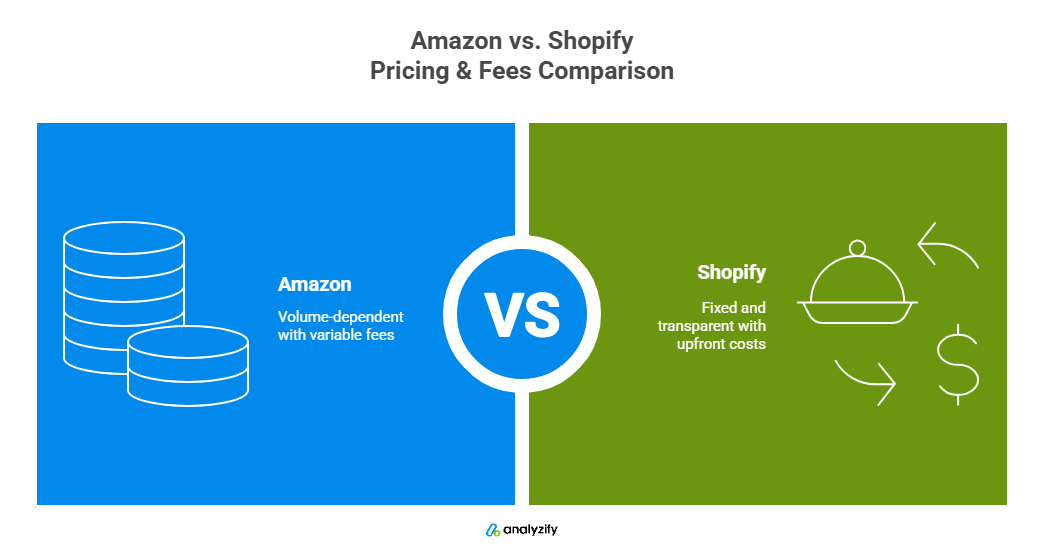
Amazon and Shopify follow very different pricing models. One is transaction-based, the other is subscription-based. Here’s how they compare in real business terms:
If you’re looking at base subscription costs:
- Amazon:
- Individual plan: $0/month + $0.99 per item sold
Professional plan: $39.99/month, unlimited sales
- Individual plan: $0/month + $0.99 per item sold
- Shopify:
- Basic: ~$29/month
- Shopify: ~$79/month
- Advanced: ~$299/month
- Plus (enterprise): Starts at $2,000/month
When it comes to how much they take from each sale:
- Amazon: Adds a referral fee of 8%–15% per transaction depending on category. If you use FBA, shipping and storage fees apply as well, these can range from $2 to $10+ per item.
- Shopify: No listing fees. If you use Shopify Payments, there’s 0% transaction fee. If you use a third-party gateway like PayPal, Shopify adds 0.5%–2% depending on your plan.
Considering fulfillment and logistics costs:
- Amazon: FBA fees cover storage, picking, packing, and shipping. Fees increase with item size, weight, and time stored. Expect extra charges during Q4 and for long-term storage.
- Shopify: Fulfillment isn’t bundled in. You’ll either ship orders yourself, use a 3PL, or apply for Shopify Fulfillment Network (available in limited regions). Costs vary and are paid separately.
If you want to control total cost and predict margins:
- Amazon: Variable fees make margins harder to control. You pay more as you sell more.
- Shopify: Fixed monthly fee offers predictability. You keep more of each sale, especially if using Shopify Payments.
Summary: Amazon’s pricing is volume-dependent and can stack up fast with referral and FBA fees. Shopify’s model is fixed and transparent, but requires upfront investment even if you have no sales yet.
How Each Platform Handles Ease of Use

Both Amazon and Shopify platforms are beginner-friendly in different ways. Amazon is simpler to launch on. Shopify is easier to grow with. Here’s how ease of use compares:
For getting started quickly:
- Amazon: Account setup is straightforward. You can list a product and start selling within hours, especially if you’re offering something already in Amazon’s catalog.
- Shopify: Setup takes more time. You’ll choose a theme, customize your store, set up payment/shipping, and write product pages. It’s guided, but requires more input.
When managing day-to-day operations:
- Amazon: Seller Central is powerful but cluttered. It handles everything, orders, inventory, reports, but the interface isn’t intuitive, especially for new users.
- Shopify: The admin panel is clean and consistent. Adding products, managing orders, installing apps, all are simple, even for non-technical users.
If you want help or onboarding support:
- Amazon: Offers Seller University (tutorials) and help articles, but no live walkthroughs. You’re largely on your own unless you’re a high-volume seller.
- Shopify: Provides step-by-step onboarding flows, tooltips, and a setup checklist. It’s designed to walk you through store launch even if you’ve never done it before.
Thinking about flexibility vs structure:
- Amazon: You follow Amazon’s rules, listing format, image guidelines, customer service policies.
- Shopify: You define how your store operates, from page layout to fulfillment methods and communication style.
Summary: Amazon is faster to launch with fewer setup decisions, but gives you less control. Shopify requires more upfront work but offers a smoother experience as your operations expand.
🎯Bonus Content: Our guide “Comparing Shopify Plans in 2025” breaks down features, pricing, and limitations so you can pick the best fit for your business stage and goals.
Business Models That Fit Amazon vs. Shopify

The right platform depends on your business model. Amazon works best for sellers who want volume without complexity. Shopify fits those focused on brand, customer experience, and long-term growth.
If you’re a reseller, wholesaler, or testing a product:
- Amazon: Ideal for selling existing products with search demand. You don’t need a website, brand, or marketing. Just list and sell, especially if others already sell similar items.
- Shopify: Not designed for resale of branded goods. You’ll need to create your own positioning and build demand. Without marketing, there’s no built-in traffic.
If you’re building a brand or DTC business:
- Amazon: You can register your brand and use Amazon Stores, but customer interaction is limited. You can’t access email lists or run retargeting ads.
- Shopify: Full ownership of branding, messaging, and customer data. Ideal for building repeat business, loyalty, and unique experiences.
For dropshipping and print-on-demand models:
- Amazon: Technically possible but tightly restricted. Amazon requires that you remain the seller of record and prohibits third-party branding in packages.
- Shopify: Built for it. Integrates directly with tools like DSers, Printful, and CJdropshipping. No restrictions on packaging or sourcing method.
If you want to scale through content, influencers, or community:
- Amazon: Not designed for this. There’s no blog, limited social sharing, and no email capture.
- Shopify: Offers all the tools to support content-driven growth, blogging, email signup, landing pages, and integration with influencer platforms.
Summary: Amazon favors sellers with ready-to-sell products and no need for customer loyalty. Shopify is better suited for businesses investing in their brand, marketing, and long-term audience.
🎯Bonus Content: Explore Top Shopify Apps for Analytics, SEO, and Marketing (2025) to find trusted tools that help you track, rank, and convert better.
How Each Platform Supports Growth
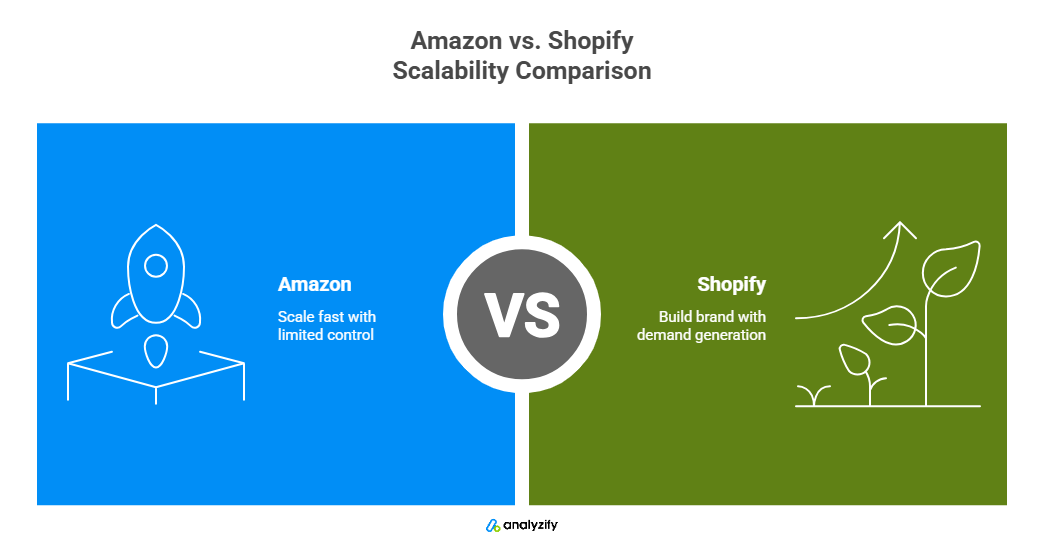
Both platforms can support growth, but they scale in very different ways. Amazon scales sales volume through exposure. Shopify scales brand and infrastructure through customization and integrations.
If your goal is to increase order volume fast:
- Amazon: The built-in traffic makes it easier to scale revenue quickly, if your product is priced competitively and optimized for Amazon search.
- Shopify: There’s no guaranteed traffic. Growth depends entirely on your marketing efforts, ads, SEO, email, partnerships.
For handling larger catalogs and operations:
- Amazon: Supports bulk listing and inventory tools, but flexibility is limited. You’re still bound to Amazon’s listing format and restrictions.
- Shopify: Handles unlimited products. You can manage complexity through apps, automation tools, and third-party integrations as you grow.
If you’re scaling a team or adding workflows:
- Amazon: Offers user permissions but is limited in workflow flexibility.
- Shopify: Supports staff accounts, custom apps, third-party logistics, and ERP integrations, especially on Shopify Plus.
When expanding into new markets or channels:
- Amazon: You scale by entering other Amazon marketplaces (e.g., Amazon UK, Amazon Japan). FBA Global simplifies logistics.
- Shopify: You control international expansion. Add multi-language support, local currencies, and new domains. Integrate marketplaces and social channels as needed.
Summary: Amazon makes it easier to scale sales fast within its ecosystem but limits how much control you have. Shopify supports scalable systems, branding, and operations, but only if you can generate demand.
🎯Bonus Content: Check out Shopify vs WooCommerce: Which Is Better In 2025 to find the right fit based on your goals, tech comfort, and business model.
Fulfillment Models of Amazon vs. Shopify
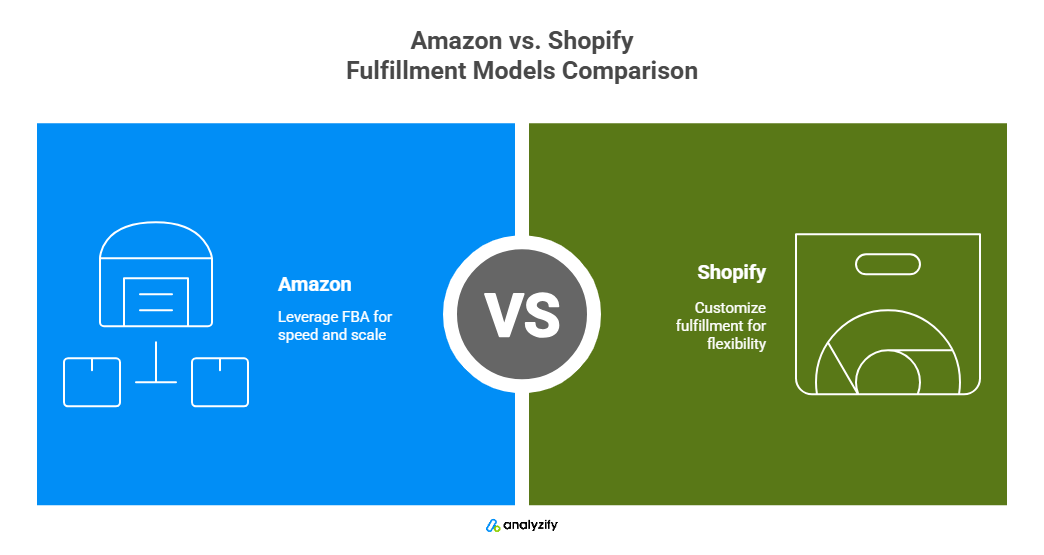
How you fulfill orders directly impacts customer satisfaction, profit margins, and scalability. Amazon and Shopify take very different approaches here.
If you want a hands-off shipping process:
- Amazon: Fulfillment by Amazon (FBA) handles storage, picking, packing, shipping, and even returns. It gives you access to Prime shipping and fast delivery expectations.
- Shopify: You fulfill orders yourself or through a third-party logistics provider (3PL). Shopify also offers a fulfillment network, but it’s limited in scope and availability.
Looking at logistics infrastructure:
- Amazon: FBA has over 100 warehouses globally and built-in last-mile delivery. It’s reliable, fast, and designed for high volume.
- Shopify: No built-in logistics system. You can access discounted shipping rates, print labels, and connect to 3PLs, but the infrastructure depends on your setup.
If you’re focused on branded delivery and unboxing:
- Amazon: Packages arrive in Amazon-branded boxes. You can’t include inserts or custom packaging. Branding is stripped from the customer experience.
- Shopify: You choose packaging, inserts, and shipping methods. Full control over the post-purchase experience.
For fulfilling orders from multiple sales channels:
- Amazon: Offers Multi-Channel Fulfillment (MCF), which lets you fulfill orders from other platforms using FBA inventory, but with limitations on branding.
- Shopify: Fully flexible. You can connect your store to Amazon, eBay, Facebook, or TikTok and manage orders from one dashboard using your preferred fulfillment method.
Summary: Amazon provides world-class logistics through FBA, ideal for sellers who want speed and scale without managing operations. Shopify offers flexibility, you can own fulfillment, outsource it, or combine both, but that freedom comes with more responsibility.
Support Experience Of Amazon vs. Shopify
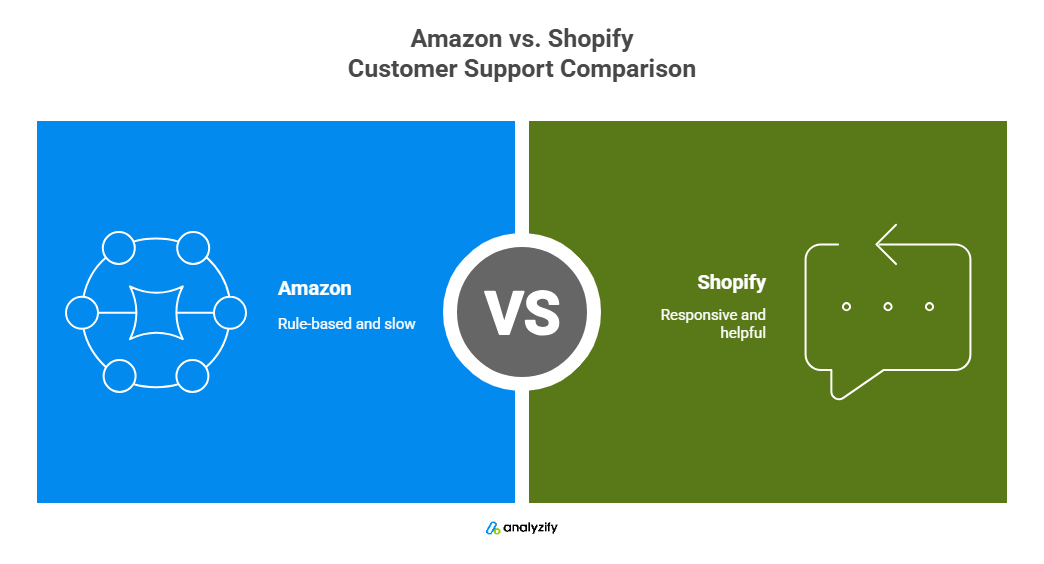
Support quality matters more as your business grows or runs into issues. The difference between Amazon and Shopify here is significant.
If you need fast, accessible help:
- Amazon: Support is available through help tickets and callback requests, but response quality is inconsistent. Many sellers report delays, generic answers, or difficulty resolving complex problems.
- Shopify: Offers 24/7 live chat, email, and phone support. Most issues are resolved quickly, and the support team is known for being merchant-focused and accessible.
For educational resources and troubleshooting:
- Amazon: Provides Seller University and help docs. Forums are active but often unmoderated. No direct onboarding or live walkthroughs.
- Shopify: Includes interactive setup guides, tutorials, and a searchable Help Center. Also offers free training via Shopify Compass.
When dealing with platform policies or account risks:
- Amazon: Policy violations can lead to instant suspensions, even for unclear reasons. Appealing decisions can be difficult. Support generally defends Amazon’s rules, not your business.
- Shopify: Far fewer account restrictions. You’re less likely to be shut down without warning. Support typically works with you to resolve issues.
Summary: Amazon’s support system exists but isn’t seller-friendly. It’s rule-based and slow to escalate. Shopify’s support is consistently more responsive and helpful, especially for small to mid-size businesses that need guidance during setup or scaling.
Platform Pros and Cons According to Users
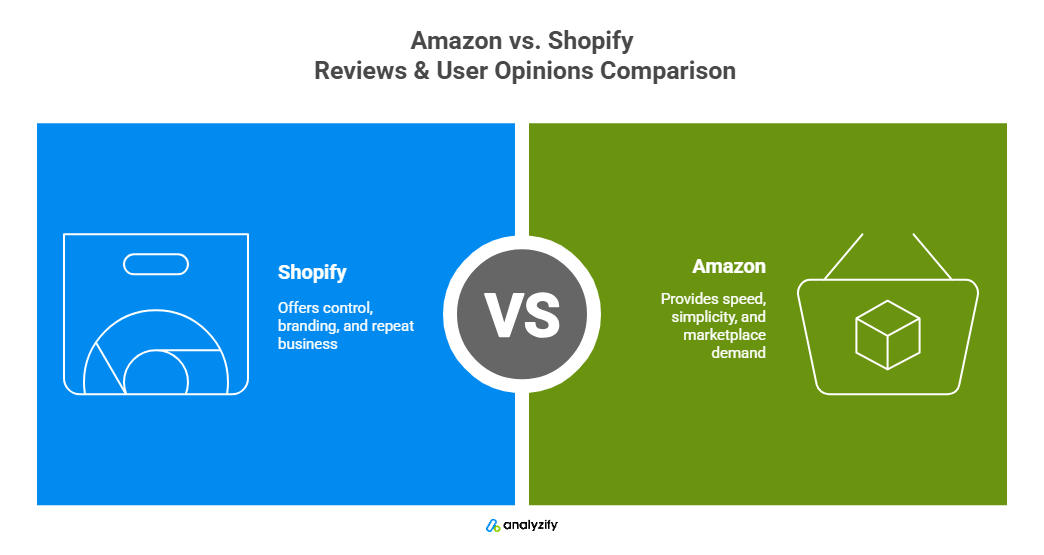
The real-world experience of sellers often reveals what platform comparisons miss. Here’s what professionals say after using both Amazon and Shopify:
If you’re focused on profitability and margin control:
- Amazon: Sellers often mention how fees add up quickly, between referral fees, FBA costs, and ad spend, profit margins shrink fast. Many say Amazon works only if your pricing and logistics are tightly optimized.
- Shopify: Users appreciate predictable costs. With no listing or referral fees, and lower fulfillment expenses (if self-managed), Shopify often offers better profit per sale.
When it comes to customer relationships:
- Amazon: Buyers belong to Amazon. You don’t get their email, can’t remarket to them, and can’t build a direct relationship. Sellers often feel like interchangeable vendors.
- Shopify: Full access to customer data. Merchants can build email lists, run loyalty programs, and retarget previous buyers, key for long-term growth.
Thinking about platform risk and competition:
- Amazon: Sellers report listing hijacks, fake reviews, and sudden suspensions as real concerns. You compete directly with other sellers, sometimes even Amazon itself.
- Shopify: You’re not competing on a shared page. It’s your store, your rules. Reviews mention how that isolation creates a sense of ownership and stability.
For first-time sellers choosing a platform:
- Amazon: Often seen as easier for beginners who don’t want to deal with traffic generation. You list, and you might sell. But success usually depends on pricing, reviews, and PPC.
- Shopify: Requires more work upfront. Sellers need to bring traffic through ads or SEO. However, many say it’s more rewarding long-term, especially if you’re building a brand.
Summary: Professionals who care about control, branding, and repeat business tend to prefer Shopify. Those looking for speed, simplicity, and marketplace demand often start with Amazon, but many eventually move away due to platform limitations.
Selling Internationally on Amazon vs. Shopify
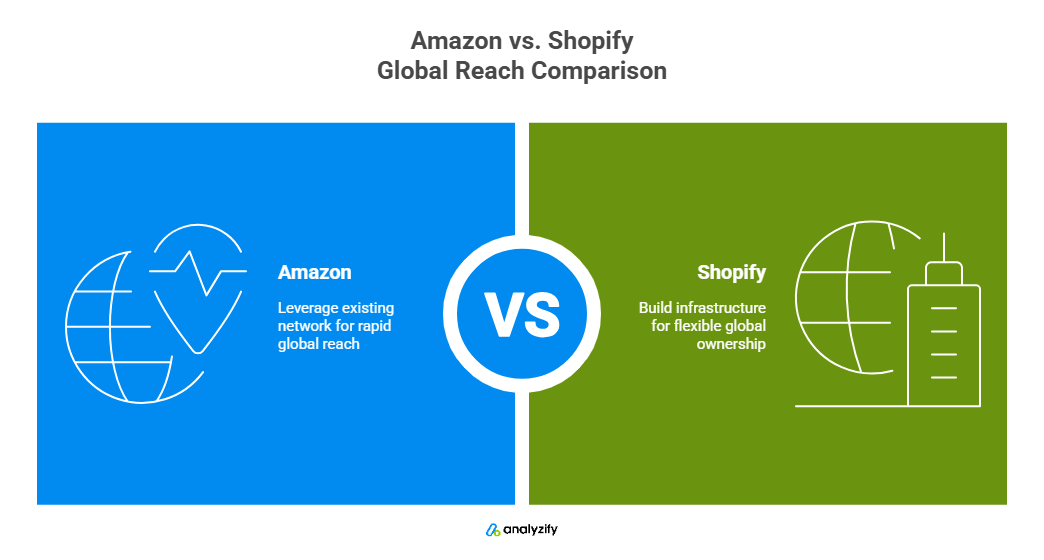
If you’re planning to sell internationally, both platforms support global operations, but in very different ways.
For sellers who want fast access to international customers:
- Amazon: Operates localized marketplaces in over 20 countries (e.g., Amazon UK, Japan, Germany). With Amazon Global Selling and FBA, you can reach international buyers without setting up separate websites or logistics partners.
- Shopify: Your store is globally accessible from day one. You can add multi-currency and multi-language support, but reaching customers in other countries depends entirely on your marketing efforts.
Looking at logistics and fulfillment across borders:
- Amazon: FBA handles international fulfillment, customs, and shipping. You can send inventory to one warehouse and serve multiple countries through programs like Pan-EU or NARF.
- Shopify: Requires more planning. You need to manage your own international shipping or contract a fulfillment partner in each region. No built-in global warehousing.
If you’re focused on localization and customer experience:
- Amazon: Listings automatically adapt to local currencies and languages. Customers already trust the platform, which lowers buying friction abroad.
- Shopify: You control localization, translate content, customize pricing by region, and tailor the checkout experience. More flexibility, but more manual setup.
Summary: Amazon offers faster global scale through its existing network and trust. Shopify offers global flexibility, but you build the infrastructure and demand yourself. In an Amazon vs. Shopify comparison for international selling, it comes down to reach vs. ownership.
Read More:
- Shopify Markets vs. Multiple Stores | Pros, Costs, Limits
- Reliable Data Analytics for Multiple Shopify Stores
Conclusion
Choosing between Amazon and Shopify depends on what you’re solving for, reach or control.
In most cases, businesses don’t stick to just one. Many start on Amazon for exposure, then build a Shopify store to take control.
Others use both in parallel, Amazon for reach, Shopify for retention. We hope this post gave you ideas to make the right decisions for your business.
Read More:
- How to Connect Shopify to ClickHouse (and Why You Might Want To)
- How to Connect Shopify to BigQuery (and Why You Might Want To)
- 7 Common Misconceptions About Server-Side Tracking for Shopify
- How Analyzify Minimizes Not Set in Google Analytics (+Why You See It)
- Cookieless Tracking on Shopify [2025]: What Merchants Need to Know
- How to Improve Your Shopify GA4 Tracking in 2025
- Cookiebot vs Shopify Native Cookie Banner (2025)

































